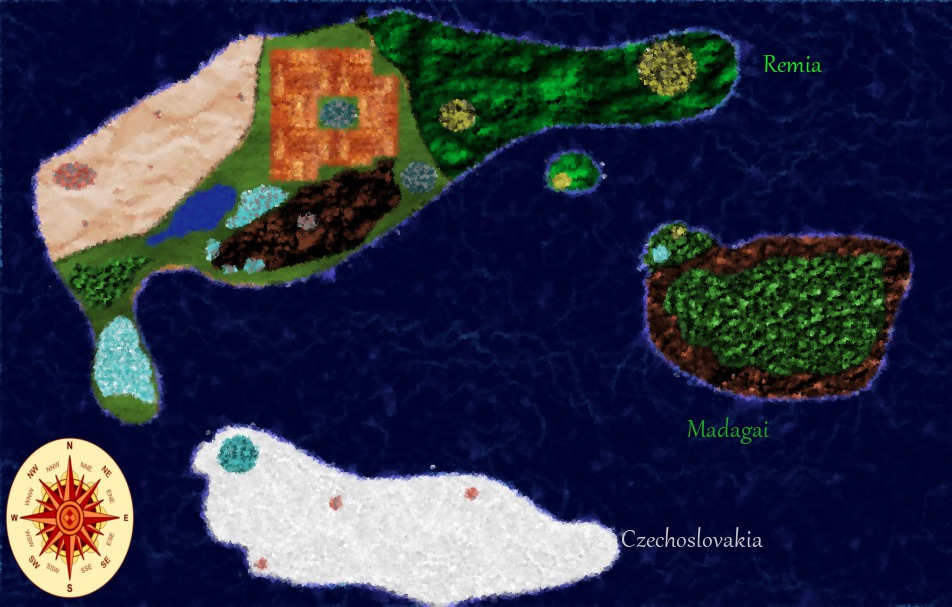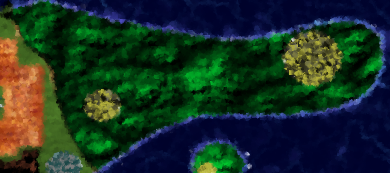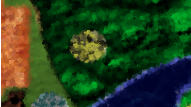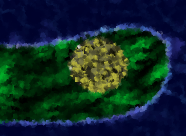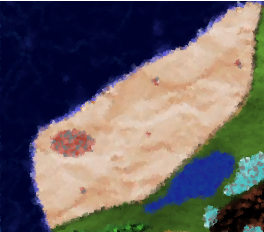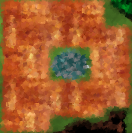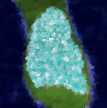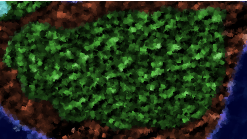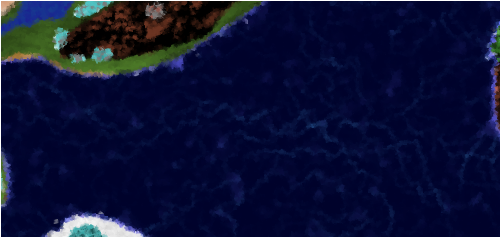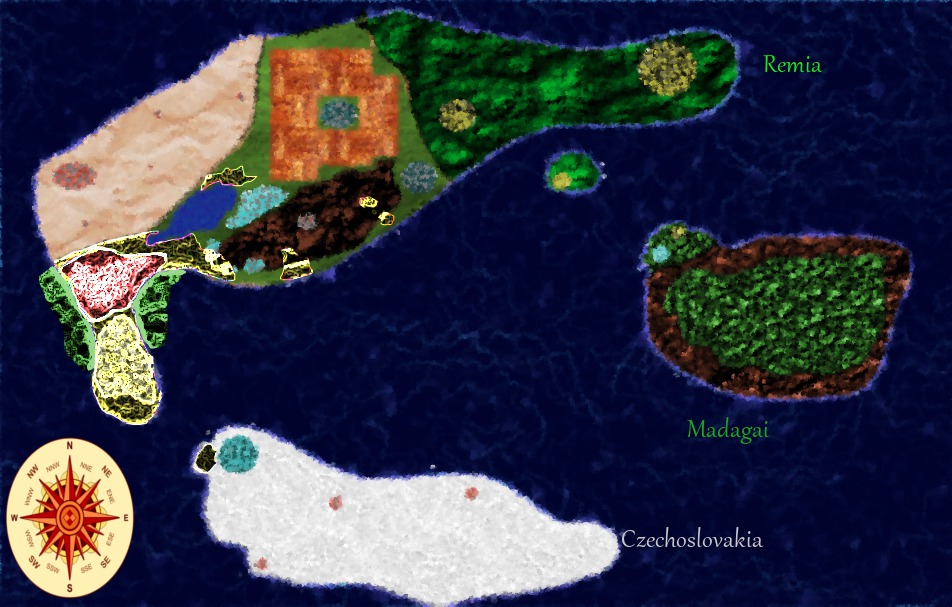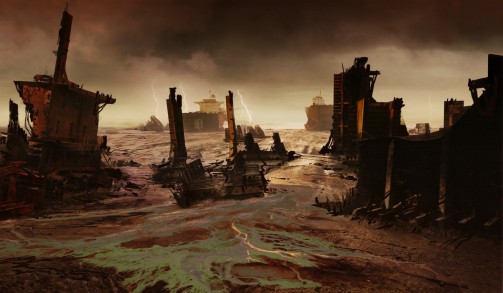Geography of Vasuda (Tiberium Rising Supplement)
Geographical/Political Locations[edit]
Califon Forest[edit]
This forest is the ancestral home of the Church of Saint Cuthbert. According to the Word, the holy book of the Church, the emissary of Saint Cuthbert met the Three Shepherds somewhere in this forest, and gave them the Order to create the Church. However, many clans of elves and other sentient beings inhabited the forest before the Church rose to power. Most have been able to coexist with the Church, and many are devotees of Saint Cuthbert. However, there are a few who hold the worship of Saint Cuthbert as sacrilege to Ehlonna and Corellon Larethian. These people, comprised of humans, elves, halflings and others who inhabit the forests, have spent centuries fighting the Church of Saint Cuthbert, and those who have forsaken the "Elder Gods of the Forests"
Evega[edit]
While the Knights' Templar is certainly dedicated to the Church, the other Orders fear the Templar may ever decide to take over the religion. For this reason, the Templar's military forces have been located in the military city of Evega since the first century. The entirety of the Templar's command, military reserves, training and armories are concentrated here. For centuries, Knights have held regular patrols throughout Califon, keeping the beasts of the wild in check. However, it was not until the discovery of the Brotherhood of Nod that any serious amount of resources were placed the military. After discovery of Tiberium, Evega practically doubled in size, since the Templar was tasked with preventing the growth of Tiberium. Another reason for the prodigious increase in military spending was the set of assassinations following the Knights' Templar - Nod War I, as many in the Church expected further conflict with the Nod.
Parsé[edit]
The capital of the Church of Saint Cuthbert, this metropolis is located in northern Remia. It is the center of government for the Church and, as such, is a splendid city filled with statues of heroic Knights and grand cathedrals. A constant garrison of knights was kept here in case the city was ever directly attacked, though such an assault is virtually unimaginable. As tensions between the Church and the Brotherhood of Nod mounted, many high ranking priests of the Church became very reclusive, building larger and larger fortifications against feared attacks by the Nod. However, no assaults ever reached Parsé. At least, not until the Invasion of the Scrin
Heraklion[edit]
This outpost of the Knights' Templar is tasked with the grim task of guarding the world against the horrors of the Labyrinth, a dimension with many entrances, but only one exit. Many foul beasts of the lower planes end up in the Labyrinth, and many try to fight their way out. The Knights of Heraklion fight ceaselessly against the creatures. Knights often send parties of warriors into the madness of the Labyrinth. While few knights ever return from these expeditions, those who do tell tales of walls moving before their eyes, and of horrible beasts that killed men in a single swipe. These battle-hardened survivors are often promoted to higher ranks within the Templar, making the Labyrinth the fastest method to rise in rank during peacetimes, though it is not without its costs. As Tiberium becomes more common on Crete, the portal begins functioning intermittently, opening for only brief moments.
Cairo[edit]
One of the most significant temples of the Brotherhood of Nod, Cairo is home to much of their research and military training. While much of the Brotherhood is decentralized, the advantages of combining their best researchers in the same area made the founding of central temples virtually unavoidable. Much of the Nod's study of Tiberium takes place in Cairo, where the Crystal is unlikely to grow if accidentally released. It was also here where Kriss Amucire's siege took place, cementing the animosity between the two organizations. Cairo was also the first heavily populated area to be crushed by Cabal during the Firstorm Crisis, and was where the Brotherhood played its final Gambit, luring the Templar's Ion Strike against a Liquid Tiberium Deposit.
Desert of Nod[edit]
This desert acquired its name long before the Brotherhood emerged from the shadows. It is the most inhospitable place in the world, with temperatures of up to 120°F. The Nod military base of Cairo and a few other cities are located in the desert, often sending patrols to look for people who have been exiled into the desert. The complete lack of moisture makes the environment impervious the Tiberium's growth, though this fact is practically useless, since it is virtually impossible to live of the land. It was also within the Desert of Nod that the Firestorm temple was located, where the construct Cabal gained sentience, and a thirst for blood.
Rome[edit]
The breadbasket of the world, Rome is quite possibly the single most important city of Vasuda. Here, virtually all of the crops throughout Vasuda are grown, from wheat and hay to fruits and vegetables. The location is ideal, since it is both far enough from the Caspian Sea to avoid too much salt in the soil, and is unencumbered by forests or tundra. Fortunately, most Romans are unconcerned with leveraging this power against the rest of Vasuda. The city is considered quite unambitious, and has never had aspirations of world domination. However, the content nature of the Romans should never be mistaken for docility. The blood of many would-be tyrants has watered the crops of Rome, and even the Word of Saint Cuthbert cautions against raising the ire of Rome.
Caspian Sea[edit]
This inland sea is quite likely the largest source of salt across all of Vasuda. Unlike the oceans that surround the continents, the Caspian sea is composed of saltwater. While exceptionally rare, saltwater is largely useless to the population at large. However, the salt in the water is highly prized, both as a seasoning and a meat preservative. Large portions of the neighboring deserts have been dedicated to drying and acquiring salt. Several desert tribes have banded together in order to defend their mutual interest in the salt beds, fending off vagrants and selling the precious mineral.
The Caspian Sea is also home to a number of indigenous species, only found in its brackish waters. Indeed, many of the creature within the sea's murky depths seem to be of an entirely otherworldly nature, lending credence to the theory that the Caspian Sea is filled by a portal from the Elemental Plane of Water.
Cambridge University[edit]
The greatest (and only) university of Vasuda, Cambridge holds the most intelligent scientists and professors of the world, save for the scientists of Nod. Cambridge's research in Tiberium is second only to the Nod, and even then only by a small margin. All citizens of the Empire recieve a free education here, though noncitizens are also allowed to attend (for a fee, of course). One of the most distinctive traits of the University is that it is not solely an academy of wizards, but that study into mundane is also encouraged.
Many of the citizens who attend Cambridge do so to earn trades, such as blacksmithing or alchemy. However, the arts also flourish at Cambridge, and attempts are even made to create a history separate from the religious history in the Word of Saint Cuthbert. Indeed, the Empire of Lenin has gathered the largest library in recorded history, and has been making a concerted effort to reproduce and translate every book found. In fact, when Emperor Lenin Trotsky is not governing in Leningrad, he is here, aiding the efforts made regarding the many texts found at Cambridge University.
Sarajevo[edit]
The Brotherhood of Nod had almost no central command structure prior to the introduction of Tiberium to the world. Before Tiberium, the Inner Circle of the Brotherhood held almost no control over any brothers, nor was any desired. The entire Inner Circle only rarely met inside their mountain fortress, secluded in the Sarajevo Mountains. However, the appearance of Tiberium and the wars with the Knights' Templar forced the Inner Circle to begin coordinating the resources of the entire Brotherhood. They began to take permanent residence in Sarajevo around 1405, which was centrally located and allowed them to dispatch messages and orders to all elements of the Brotherhood. Fortunately for the Nod, difficulties in even finding the mountain installation left the Brotherhood's commanders relatively safe throughout most of the KT-N Wars.
Nochston Mines[edit]
These three mines are where Vasudans mine the earth for iron and other valuable materials. Only nominally associated with the Empire of Lenin, the mines were free to sell the raw resources of the other to whomever they saw fit. However, trade routes leading to the mines were solely the property of the Empire, which limited many would-be buyers from less than trusted organizations. During the Knights' Templar - Nod Wars, the Nochston Mines sold most mined minerals to the Church of Saint Cuthbert, though plenty of materials were sold surreptitiously to the Nod
Brocton Forest[edit]
Before the construction of Leningrad, this forest used to span the entire Imperial Isthmus. During the rise of the Knights' Templar, and the various groups opposed to them, the Brocton Forest became home to many who found close proximity to the Church to be disagreeable. However, the rise of the Empire of Lenin and the founding of Leningrad required significant swaths of the forest to felled. Most forest residents were comfortable with joining the Empire, largely because the Empire compensated them handsomely for the "renovation" of their homelands. However, a significant number of Church dissidents returned to the Califon to renew the war with Saint Cuthbert, and a number of non-humans have begun retaliating against the Empires expansion throughout the Isthums.
Leningrad[edit]
The largest, most prosperous city on Vasuda to date, Leningrad is the capital of Empire of Lenin. Here, all manner of goods and services can be purchased, from bread and carpenters to alchemical reagents and mages. Much of Nochston's mined materials end up here, and are fashioned into a menagerie of nonlethal materials. It is also here where Emperor Lenin Trotsky spends much of his time governing, coordinating the trading caravans of the Empire.
Leningrad's construction required the destruction of much of Brocton forest, which originally spanned the entire Imperial Isthmus. While all of the previous inhabitants were generously compensated, a few resent being forced from their ancestral glades. A minority have taken up arms, and have been sabotaging the Empire at every step, usually by burning buildings made of their former homes.
Savlon[edit]
While the arctic expanses were divined by clerics shortly after the founding of the Church of Saint Cuthbert, the treacherous nature of the freshwater oceans made travel there impossible. At was not until 1176 KTR that an intrepid clan of explorers made the dangerous trek to the unexplored continent. Their journey against the harsh storms of the Krostal Ocean wrecked their boat, and without any source of wood from the tundras of Czechoslovakia, they were stranded in the desolate frosts.
However, the explorers persevered, and managed to thrive against hostile conditions. They survived by eating the few shrubs found in the tundra, and hunting some of the massive beasts that roamed the land. Shelters were made from the skeletons, hides and ice harvested during hunts, and fires were maintained with a variety of spells. The explorers founded the city of Savlon, and continued with their original purpose: to map Czechoslovakia.
Savlon remained isolated until 1374 KTR, when the Empire of Lenin finally made craft sturdy enough to make the journey from the southern tip of the Imperial Isthmus to Czechoslovakia with any amount of reliability. Rather than finding the wreckage of a long dead exploration crew, they instead came across the hardy people of Savlon, many of who still maintained their ancestors passion for exploration.
Czechoslovakia[edit]
The majority of Czechoslovakia is made up of desolate, frozen wastes. This isolation has made the area perfect for a number of Nod research outposts, but little else graces the surface of the continent. The lack of life and liquid water even keeps Tiberium from spreading throughout the continent, leading to their colloquial name, the Pure Plains.
However, the people of Savlon have not spent the better part of 250 years exploring featureless tundra. They have found a massive tunnel network stretching underneath the entire continent. Many people from Savlon have spent their lives mapping the labyrinthine caverns underneath the tundra, but even with their dedicated efforts, experts expect that over 95% of the caves remain untouched.
Antananarivo[edit]
This is the area was colonized by the Church of Saint Cuthbert in 1250, and became known as 'Antananarivo'. The Church colonized the area as a conversion outpost, to try to bring the Word of Saint Cuthbert to the secretive people of the jungles of the island-continent, though not one of the natives have ever tried to communicate with the colony. While the Empire has tried to communicate with the natives, it became obvious the natives did not wish to interact with the colonists. The Empire's outpost now spends most of its time identifying the odd species of the Jungle Heart.
Jungle Heart[edit]
The cliffs surrounding the Jungle Heart prevented exploration until 1273, when a path through the mountains near Antananarivo was finally discovered. What awaited the Templar was a dense jungle, filled with threats at every turn. After two weeks, the Templar had almost ended its exploration when a Knight found evidence of humans living in the jungle. The Templar spent the better part of the next year trying to track down the inhabitants of the jungle, in an attempt to bring them the Word. However, the venture was abandoned after several Knights were lost to beasts that roamed the jungles. The outpost Antananarivo was formed to beckon any natives to the civilization of the Church, though none of the half-glimpsed people in the Jungle Heart have ever approached the makeshift cathedral.
The Jungle Heart laid untouched for the next century, until citizens of the Empire of Lenin began documenting new species on the edge of the jungles. However, the Jungle Heart became of acute interest when the Brotherhood of Nod revealed that a portion of the Tacitus was located deep within the Jungles, forcing Brothers and Knights to forge their way deep into the jungles. There, the unseen tribes of the Heart were found to be worshipping the piece of the Tacitus. After a fierce battle, where all of the Nod elements of the team "mysteriously" vanished, the natives were held at bay while the Tacitus was sent to Remia.
Krostal Ocean[edit]
The oceans of Vasuda are composed entirely of fresh water, which has a profound effect on weather and climate. Since freshwater freezes more readily, the size of Czechoslovakia is exaggerated by ice, and icebergs are a common sight on the ocean. However, the oceans are free from sailors. Freshwater makes floating boats slightly more difficult, but it also evaporates readily. The massive influx of atmospheric water means that storms are far more common, and far more deadly. All of these hazards have made ocean travel a near impossibility. Indeed, contact with Madagai and Czechoslovakia have only been made very recently, despite their relatively short distance from Remia.
Tiberium[edit]
Vasuda, 1412 KTR
Blue Zones[edit]
These regions are the default of the map, and are completely free from Tiberium. Blue Zones quickly become the most prized land on Remia, since they are free from the background radiation which eventually effects everyone in other zones. The Church of Saint Cuthbert rules virtually unchallenged in these regions, largely because they are the ones who remove all Tiberium discovered. However, the Church faces an uphill battle, due to the difficulty of having Knights combing an entire region and finding every single crystal. As time and Tiberium progress, most efforts are eventually concentrated in keeping important agricultural areas clear, such as Rome.
Yellow Zones[edit]
Most of these areas have suffered from social collapse due to extreme weather changes, Tiberium infestation, and decades of war; however, Yellow Zones still hold most of the population of Vasuda. The Brotherhood of Nod works diligently to gain followers in these areas, convincing inhabitants that the Church and Empire have forsaken them. Many areas, particularly those close to Blue Zones, act as staging areas and frontline bases for the Knights' Templar. Due to the growth of Tiberium throughout the Imperial territory, the Empire of Lenin also primarily operates in Yellow Zones, attempting to coordinate trading caravans and conduct research into halting the growth of the crystal
Red Zones[edit]
Red Zones are areas of the planet that are contaminated by vast amounts of Tiberium, and are frequently hit with Ion storms. Owing to the prevalence of Tiberium, the Red Zones are almost completely uninhabited, save for a few groups of Forgotten and other Tiberium-based life, such as Visceriods. The Brotherhood and the Empire also maintain small outposts in these lands, conducting research with Tiberium. Such outposts are often well defended, due to dangerous mutants.
Tiberium Algae[edit]
Tiberium Algae is an especially corrosive form of Tiberium, only found in bodies of fresh water. Exposure to contaminated water inflicts 2d6 damage per round, though full immersion deals 20d6 damage per round. Tiberium mutants are resistant to this corrosion, and only take half damage. Tales abound of aquatic creatures perfectly adapted to the hostile environment.
An interesting note is that Tiberium Algae is unique to freshwater. Bodies of saltwater, such as the Caspian Sea, are never contaminated by the crystalline plague. This fact played a significant role in attempts at controlling the growth of Tiberium.
Ion Storms[edit]
Vasuda's freshwater oceans cause an inordinately high amount of catastrophic weather events, from hurricanes to twisters. The introduction of atmospheric Tiberium has added another threat to the list: Ion Storms. As the saturation of Tiberium in the air increases, so does the chance of devastating electrical storms, known as an ion storms. It is unknown precisely what factors trigger an ion storm, but they frequently occur in areas of heavy Tiberium contamination. During an ion storm, the sky is obscured by a yellow haze, limiting visibility by 75%. Devastating ion bolts strike the ground, where a single bolt deals 10d8 points of electrical damage, regardless of hardness. Due to decreased atmospheric pressure, meteorite strikes are also more common during ion storms.
Back to Main Page → 3.5e Homebrew → Campaign Settings → Tiberium Rising

